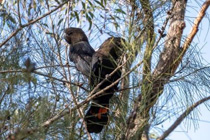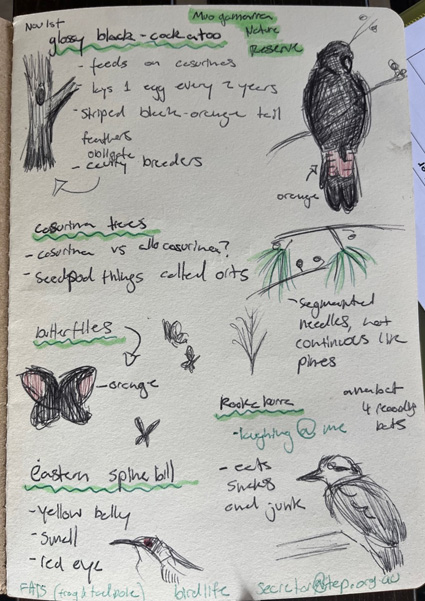‘What an amazing opportunity …’ was a student response overheard during a lunch conversation at the recent biodiversity survey held at Muogamarra Nature Reserve on 1 November 2023. Now in its second year, the biodiversity camp coordinated by Gibberagong Environmental Education Centre (GEEC) and the NSW National Parks and Wildlife Service provides an opportunity for students to learn about their local environment, fauna, wildlife survey techniques and careers in the environmental field.
GEEC staff, teachers and students were overjoyed by the support offered by our local community-based environmental organisation, STEP. STEP so willingly offered a grant to help financially support this important project. With living costs at a high, the grant provided by STEP helped us subsidise the cost of the experience to students, purchase ten pairs of binoculars and help pay for secondary teachers to attend.
Year 10 students from Ku-ring-gai HS and Turramurra HS were invited to apply for this opportunity. Upon meeting these students in the morning, one could immediately pick up on the passion and interest of these young people.
 It was most disappointing for all involved to learn of a total fire ban on the Tuesday. This meant that all tracks were closed and our extensively planned overnight biodiversity camp could not run in the original format. Unfortunately, we could not do the overnight component. Due to the challenges in coordinating such events, were very lucky to proceed with a full day event on the Wednesday.
It was most disappointing for all involved to learn of a total fire ban on the Tuesday. This meant that all tracks were closed and our extensively planned overnight biodiversity camp could not run in the original format. Unfortunately, we could not do the overnight component. Due to the challenges in coordinating such events, were very lucky to proceed with a full day event on the Wednesday.
There was a silver lining in running a modified program. As we travelled into Muogamarra early in the morning we spotted two families of Glossy Black-Cockatoos. This was an amazing experience and opportunity for our students to observe this beautiful species feeding early in the morning on specific feed trees. It also provided our resident Glossy Black-Cockatoo expert and NPWS Chase Alive Volunteer, Barbara Hamilton with the opportunity to collect valuable observational data on these birds.
During the morning, the students were very fortunate to listen to two expert presentations. The first presentation was delivered by Kathy Potter from the Frog and Tadpole Study Group (FATS). Kathy so generously shared her expertise on local frog species, identification, habitats and how we can encourage frogs into our urban landscape.
This was then followed by an excellent presentation by Barbara Hamilton, Chase Alive Volunteer and local bird expert. Barbara spoke taught the students about local bird identification, evolutionary history of birds, bird distribution and how to attract a variety of birds to our home environments.
Armed with our fantastic binoculars, funded fully by STEP, we were set to conduct our survey walks. We listened and looked for all animals, especially birds. The students also collected the wildlife cameras that were set-up in the weeks prior to the survey.
 Unfortunately, we did observe a European Red Fox on the wildlife camera. This will be provided to the NSW National Parks and Wildlife Service for future management of the site.
Unfortunately, we did observe a European Red Fox on the wildlife camera. This will be provided to the NSW National Parks and Wildlife Service for future management of the site.
Despite the limitations on the surveys, we did manage to identify over twenty species of animals during the survey. This information will be provided back to NPWS. Ideally, we would like to have completed more surveys during the evening and very early morning.
The major benefit of this fieldwork is the seed that has been sown in our next generation. The students were overwhelming enthusiastic about learning about our local environments, especially our fauna. They felt more connected to their local environment and have left with not only more knowledge about fauna, habitats, and survey techniques. Most importantly, the students left with an even deeper passion and love for our natural environment. So much so, they are going to do follow-up fauna surveys at their own schools as well as present their learnings to their broader school community.

Gibberagong EEC would like to express our deepest gratitude to all involved – teachers and students, STEP, NPWS, Kathy and David Potter (FATS), Barbara Hamilton (Chase Alive) and Gibberagong staff.
Brad Crossman, Teacher, Gibberagong Environmental Education Centre












